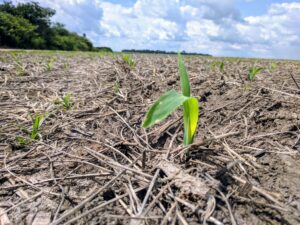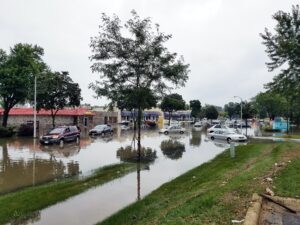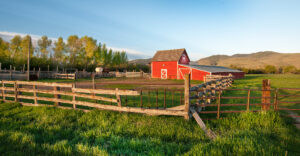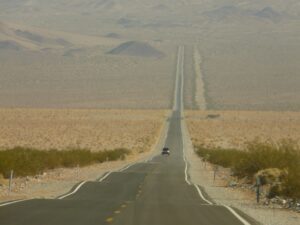Can farmers fight climate change? New U.S. law gives them billions to try
Cutting emissions from fertilizer and livestock will be key, scientists say

Tanguro Ranch, Brazil 2018
When settlers plowed the North American prairie, they uncovered some of the most fertile soil in the world. But tilling those deep-rooted grasslands released massive amounts of underground carbon into the atmosphere. More greenhouse gases wafted into the skies when wetlands were drained and forests cleared for fields. Land conversion continues today, and synthetic fertilizer, diesel-hungry farm machinery, and methane-belching livestock add to the climate effects; all told, farming generates 10% of climate-affecting emissions from the United States each year. Now, Congress would like to turn back the clock and return some of that carbon to the soil.
Woodwell Climate Research Center has worked for years to understand and highlight the scale of the global climate crisis and has called upon policymakers to act with urgency in addressing this threat. The Inflation Reduction Act (IRA) is historically significant legislation, providing incentives and policy tools to dramatically reduce U.S. greenhouse gas emissions and put the United States within reach of its nationally determined contribution (NDC) for climate action.
A robust analysis by Princeton University’s ZERO Lab estimates the impact of IRA projects on greenhouse gas emissions to be a reduction to 40 percent below 2005 levels, by 2030. The U.S. NDC sets a target of 50 percent reduction below 2005 levels. With additional action from the private sector and state and local governments, the United States has a realistic chance to meet its current climate targets and set a path toward a safe and stable climate.
Of course, this legislation is not perfect. In particular, there are fossil fuel provisions in the bill that seem antithetical to climate action. But the net result of this legislation is overwhelmingly positive for the climate, and is the most substantial step forward for climate policy in U.S. history.
Numerous sections of the bill touch on areas of specific Woodwell expertise. Natural climate solutions are essential for meeting both U.S. and global emissions targets, and Woodwell scientists have focused much of their research on the most effective strategies to maximize carbon storage in forests and soils. The IRA invests heavily in natural climate solutions.
FORESTRY
The Inflation Reduction Act addresses the fact that climate change can accelerate wildfires, and also the importance of trees and forests for carbon sequestration and climate change mitigation. Among other forestry provisions:
- The Act includes $2.15 billion for National Forest System land restoration and fuel reduction, with a particular focus on “the wildland-urban interface.” Fires in these areas present the most significant danger to human health and safety.
- This $2.15 billion includes $50 million “for the protection of old growth forests on National Forest System land and to complete an inventory of old-growth forests and mature forests within the National Forest System.” Woodwell research has shown that old growth forests are critically important for carbon sequestration.
- The Act also includes $550 million for grant programs dedicated to non-federal forest landowners. This includes:
- $150 million for a grant program that will support “a cost share to carry out climate mitigation or forest resilience practices in the case of underserved forest landowners.”
- $250 million for grants that will help underserved forest landowners or landowners of forest lots less than 2,500 acres participate in emerging carbon markets.
- $1.5 billion over nine years for grants that will drive urban and community forestry projects and $700 million for the Forest Legacy Program.
AGRICULTURE
The Inflation Reduction Act provides significant incentives for improved agricultural techniques that would, among other benefits, increase soil carbon sequestration. Existing federal agricultural conservation programs, for example, are heavily oversubscribed, and the Act provides additional funds to help farmers and ranchers implement and expand practices that would reduce greenhouse gas emissions. Woodwell scientists have been among the leaders in researching the potential of soil carbon as a climate change mitigation tool, and the processes for measuring, monitoring, and validating increased sequestration. Among other conservation and agricultural provisions, the Act includes:
- More than $20 billion in overall funding to help farmers mitigate climate change, including significant funding for “agricultural conservation practices” that “directly improve soil carbon, reduce nitrogen losses, or reduce, capture, avoid, or sequester carbon dioxide, methane, or nitrous oxide emissions, associated with agricultural production.”
- $1.3 billion for the Natural Resources Conservation Service to provide technical assistance and collect field-based data on greenhouse gas emissions associated with agricultural practices.
RISK
The Inflation Reduction Act recognizes the current and increasing physical hazards presented by climate change, and the fact that many communities are not prepared for climate change impacts. Woodwell works with local governments around the world to provide granular climate services, free of charge. There remains, however, an enormous need to expand this science and to provide funding to support adaptation measures.
- The Inflation Reduction Act provides $3 billion in Environmental and Climate Justice Block Grants. Among the eligible uses of this funding are “mitigating climate and health risk from urban heat islands, extreme heat, wood heater emissions, and wildfire events,” as well as general “climate resiliency and adaptation.”
- The bill includes $4 billion to increase drought resilience in the Western United States.
As Boston heat records fall, scientists see climate change’s fingerprints

Point to a string of 90-plus-degree days in Boston and call it climate change, and someone might tell you: There have always been hot days.
And it’s true. The historical records are full of occasional blips when temperatures soared.
But the relentless heat of this summer — the heavy curtain that has hung over Boston, making the air thick and the going slow — is different, and has been made more likely to happen thanks to climate change, according to scientists. And while these seemingly endless strings of scorching temperatures feel terrible, these experts say they are just a taste of what’s to come.
Continue reading on The Boston Globe.
Jet stream stokes both deadly Midwest flooding and Northwest heat

Deadly floods are slamming the US Heartland. More than 2,000 miles away, dangerous heat is scorching the Pacific Northwest. The same phenomenon is to blame for both.
A massive bend in the jet stream — narrow bands of high winds encircling the Earth — is causing the havoc. In the Northwest, the jet steam has curved far north, allowing hot air to surge into Oregon and Washington. In the Midwest and Appalachia, it’s dipped south, bringing cool from Canada that’s colliding with with tropical air from the Gulf of Mexico, triggering ruinous downpours in Missouri and Kentucky.
It was supposed to be a quiet season, but only two months into summer and Alaska is already on track for another record-setting wildfire season. With 3 million acres already scorched and over 260 active fires, 2022 is settling in behind 2015 and 2004 so far as one of the state’s worst fire seasons on record. Here’s what to know about Alaska’s summer fires:
2. Historic fires are Burning in Yukon-Kuskokwim Delta and Bristol Bay
Southwestern Alaska, in particular, has been suffering. The season kicked off with an unseasonably early fire near Kwethluk that started in April. Currently, the East Fork Fire, which is burning near the Yup’ik village of St. Mary’s, AK, is among the biggest tundra fires in Alaska’s history. Just above Bristol Bay, the Lime Complex— consisting of 18 individual fires— has burned through nearly 865,000 acres. One of the longest lasting fires in the Lime Complex, the Upper Talarik fire, is burning close to the site of the controversial open-pit Pebble Mine.
2. Seasonal predictions showed a low-fire season
For Dr. Brendan Rogers, who was in Fairbanks, AK for a research trip in May, the explosive start of the fire season contrasts strongly to conditions he saw in late spring.
“It was a relatively average spring in interior Alaska, with higher-than-normal snowpack. Walking around the forest was challenging because of remaining snow, slush, and flooded trails,” said Dr. Rogers.
Early predictions showed a 2022 season low in fire due to heavy winter snow. But the weather shifted in the last ten days of May and early June. June temperatures in Anchorage were the second highest ever recorded. High heat and low humidity rapidly dried out vegetation and groundcover, creating a tinderbox of available fuel. This sudden flip from wet to dry unfolded similarly to conditions in 2004, which resulted in the state’s worst fire season on record.
3. Climate Change is accelerating fire feedback loops
The conditions for this wildfire season were facilitated by climate change, and the emissions that result from them will fuel further warming. The hot temperatures responsible for drying out the Alaskan landscape were brought on by a persistent high pressure system that prevents the formation of clouds— a weather pattern linked to warming-related fluctuations in the jet stream.
“With climate change, we tend to get more of these persistent ridges and troughs in the jet stream,” says Dr. Rogers. “This will cause a high pressure system like this one to just sit over an area. There is no rain; it dries everything out, warms everything up.”
The compounding effects of earlier snowmelt and declining precipitation have also made it easier for ground cover to dry out rapidly under a spell of hot weather. More frequent fires also burn through ground cover protecting permafrost, accelerating thaw that releases more carbon. According to the Alaska Center for Climate Assessment and Policy, the frequency of big fire seasons like this one are only increasing— a trend expected to continue apace with further climate change.
Additionally, this summer has been high in lightning strikes, which were linked to the ignition of most of the fires currently burning in Alaska. Higher temperatures result in more energy in the atmosphere, which increases the likelihood of lightning strikes. On just one day in July over 7,180 lightning strikes were reported in Alaska and neighboring portions of Canada.
4. Communities are Being Affected Hundreds of Miles Away
The destruction from these wildfires has forced rural and city residents alike to evacuate and escape the path of burning. Some residents of St. Mary’s, AK have elected to stay long enough to help combat the fires, clearing brush around structures and cutting trees that could spread fire to town buildings if they alight.
But the impact of the fires is also being felt in towns not in the direct path of the flames. Smoke particulates at levels high enough to cause dangerously unhealthy air quality were carried as far north as Nome, AK on the Seward Peninsula.
“Even though a lot of these fires are remote, that doesn’t preclude direct human harm,” says Woodwell senior science policy advisor Dr. Peter Frumhoff.
Recent research has shown that combatting boreal forest fires, even remote ones, can be a cost effective way to prevent both these immediate health risks, as well as the dangers of ground subsidence, erosion, and loss of traditional ways of life posed by climate change in the region.
5. The season is not over yet
Mid-July rains have begun to slow the progression of active fires but, according to Dr. Frumhoff, despite the lull, it is important to keep in mind that the season is not over yet.
“The uncertainty of those early predictions also applies to the remainder of the fire season — we don’t know how much more fire we’ll see in Alaska over the next several weeks.”
Climate risk Assessment: Summit County, Utah

Background
The impacts of climate change on the frequency and severity of physical hazards are putting many communities at risk. As the threat of climate change grows, so too does the need for accessible information, tools, and expertise to support climate-resilient decision making for municipalities. Woodwell Climate Research Center (“Woodwell”) believes there is a need to localize and customize climate risk assessments. This information is critical for local government leaders as they make planning decisions, but it is not available to all communities. Woodwell believes that the science should be freely and widely available. To address this gap, Woodwell works with communities across the world, including Summit County, UT, to provide municipal climate assessments, free of charge.
Introduction
As a result of climate change, drought is expected to become more frequent and extreme in Summit County, UT. Coupled with population growth, more extreme droughts will increase water scarcity in the region. These dry conditions will also lengthen the wildfire season. Factors such as income, profession, and proximity to wildlands will affect residents’ capacity for resilience during drought and wildfire events. Here we present our findings on severe drought, water scarcity, and wildfire danger days paired with wildland-urban interface and income data to help Summit County create a more resilient future.
Drought
The frequency of severe drought is expected to increase in the future for Summit County. Drought stress is based on the Palmer Drought Severity Index (PDSI), a metric used by the U.S. Drought Monitor. In the past two decades (2000–2020), central Summit County experienced severe, or worse, drought ≤ 20% of the time (Fig. 1a). By mid-century (2040–2060) and late-century (2071–2090), severe drought stress will increase to ≤ 30% of the time for this region (Fig. 1b and c).
In 2000–2020, the northern and easternmost regions of Summit County experienced severe drought conditions around 40% of the time. These conditions are expected to increase to around 50% of the time by mid- to late-century.
Park City1 experienced severe drought conditions ≤ 20% of the time in 2000–2020, and this is expected to increase to around 36% of the time by mid-century and 41% by late-century.
Water Scarcity
Whether used for drinking water, agriculture, or recreation, water underpins the health and economy of Summit County. Unfortunately, residents have already faced the hardships associated with water scarcity. Residents who rely on well water have experienced lower water quality as wells dry due to drought. In October 2021, a prolonged drought brought Echo Reservoir and Rockport Reservoir down to 11% and 26% of their total capacity. Towns responded by taking dramatic action in order to meet residents’ water needs. For example, Echo had water shipped in via fire truck. Both Oakley and Hennifer halted new construction that connected to city water. Farmers and ranchers have had to make hard decisions on how to irrigate crops and feed livestock. Small operators are especially at risk. As the climate changes, water will continue to be a crucial resource to preserve and protect.
We utilize a Water Scarcity Index (WSI) to determine the level of water scarcity in Summit County. The WSI is a relative global percentile ranking system based on ten hydrological variables using historical observations and future model projections.2 The Index indicates that 43,017 people living in Summit County face high water scarcity. This is equivalent to 97% of the county’s population. We use gridded 2020 population data from WorldPop3 to determine the population at risk. In the west where most of the county’s population resides in the major cities of Coalville, Park City, Oakley, and Kamas, the WSI score is in the 80th percentile compared to all other locations in the world, which we consider as high water scarcity (Fig. 2, left).
One factor driving high water scarcity is groundwater risk in the east. In the WSI, groundwater risk is measured by the time when groundwater pumping starts to impact environmental streamflow, a point known as the environmental flow limit, due to unsustainable rates of groundwater abstraction and low levels of groundwater recharge. Negative impacts of reaching the environmental flow limit include discharge from groundwater to streams to decline, reverse in direction, or stop altogether. In rural regions, groundwater is the primary and often only water source. As surface water resources become more strained, the reliance on groundwater will likely increase but will be limited by availability and quality. In the far eastern region of Summit County, the environmental flow limit was already reached as early as 2012 (Fig. 2, center). Roughly 5% of the population, or 2,136 people, live in an area where the limit was already exceeded. In the central Summit County and the Snyderville Basin, the environmental flow limit is not expected to be reached in this century. Park City may have additional exposure as they import water from the Jordanelle Reservoir, which surpassed its environmental flow limit in 1982.
The second main driving factor is high projected water stress throughout the county. Water stress is defined as the ratio of water withdrawals to available renewable water. In 2030 (midpoint of 2021–2040), the major cities in Summit County are projected to have a water stress ratio of 189% (Fig. 2, right). That means water demand is expected to be almost twice as much as available water supply. For reference, a high water stress ratio is considered to be 40%.4 The 2030 projected water stress in Coalville, Park City, Oakley, and Kamas is nearly 5x that amount. In the southern area of the Weber River watershed, the water stress level is projected to be as high as 250%. Generally, across the county, water stress increases 1.4x compared to 1986–2005 levels. High projected water stress in Summit County is driven by an increase in water demand as well as a decrease in water supply.
Wildfire
To assess future change in wildfire danger for Summit County, we analyzed Fire Weather Index (FWI) data. FWI is a daily, unitless measurement of wildfire danger, derived from temperature, relative humidity, wind speed, and precipitation. This metric was developed by the Canadian Forest Service and is used globally, including in the United States, to quantify fire risk.
The change in wildfire danger days (Fig. 3) was calculated by determining the additional number of days per year in the future that are predicted to have a FWI value greater than the historical (2000–2020) extreme (1-in-20-day occurrence) FWI value. This threshold indicates a high-danger wildfire day, where fires have the potential to quickly grow out of control in the event of natural or human-caused ignition. By mid-century (2040–2060), much of Summit County can expect up to an additional six wildfire danger days per year (Fig. 3a). By late-century (2070–2090), central Summit County could experience up to an additional eight wildfire danger days per year compared to 2000–2020 (Fig. 3b). Easternmost and northwestern regions can expect an annual average additional 11 wildfire danger days by late-century, signifying a yearly increase of 60%.
Like many communities, Summit County has limited funds and resources available for wildfire prevention and suppression. The county can better prepare for the future by focusing on regions where wildfires have the greatest potential to cause damage to life and property. Figure 4 overlays human footprint data7 (indicating populated areas, housing, roads, etc) with biomass8 (trees and other vegetation) from 2018 to identify wildland-urban interfaces—potential hotspots for costly wildfires. The western side of Park City stands out as a region with a high human footprint and large amount of burnable vegetation. This area is also projected to see an increase in wildfire danger days (Fig. 3) and should be a main focus for wildfire mitigation. Building up defensible space around properties on the edge of town and conducting low-intensity prescribed burns that clear underbrush are two actions that can help reduce wildfire risk and severity for the city and surrounding areas and cultivate a healthy, diverse forest.
Past wildfire boundaries9 within Summit County from 1980–2019 are presented in Figure 5. The human footprint layer is once again overlaid to show where these historical fires occurred relative to human development. The county has experienced multiple wildfires along I-80 in the past three decades, including the 2013 Rockport Fire that burned over 2,000 acres near Atkinson and just a few miles northeast of Park City.
Not all residents of Summit County will be impacted equally in the event of a wildfire. Those with limited income will be disproportionately affected, as they often lack the resources to clear areas around their homes and recover economically in the event of a fire. The percent of individuals living below the 200% Federal Poverty Level (FPL)10 in Summit County are displayed in Figure 6 to highlight census blocks with vulnerable individuals. More than 25% of the population in northwestern Summit County is below the 200% FPL, and multiple wildfires have occurred in this census block in recent decades. Multiple census blocks in populous southwestern Summit County, including parts of Park City, have between 20–25% of individuals below the 200% FPL. Allocating resources to help limited-income residents develop and maintain defensible spaces around their homes is one preventative measure Summit County can take to aid in the reduction of wildfire risk in vulnerable communities. Provision of additional support for limited-income individuals after a wildfire event is also crucial in helping disproportionately impacted residents in their recovery.
Explainer: What’s causing the recent U.S. heat waves?

Much of the United States will experience another heat wave this week, with above-normal temperatures forecast for the Pacific Northwest, Southern Plains and the Lower Mississippi Valley.
The extreme heat is fueling a fast-moving California wildfire, just went of Yosemite National Park. The Oak Fire has destroyed 10 structures and is 10% contained.
The U.S. heat wave followed record heat that killed hundreds if not thousands of people and sparked wildfires in Europe.



